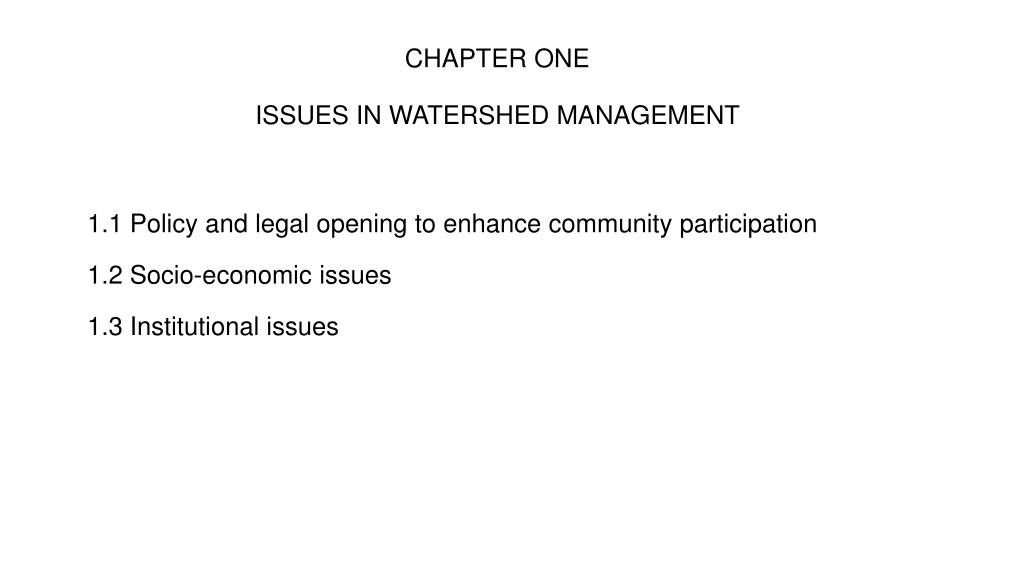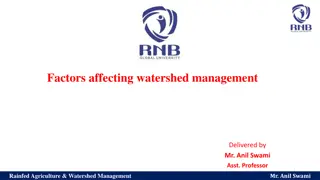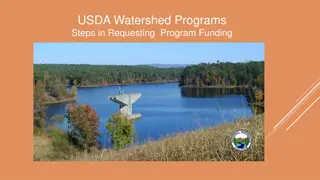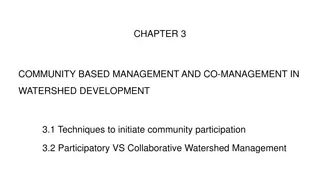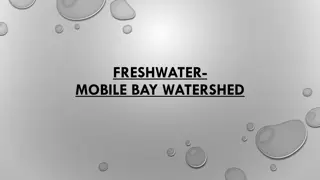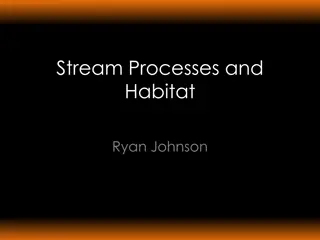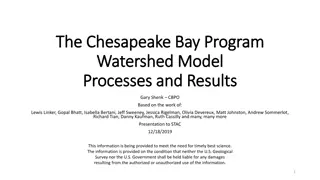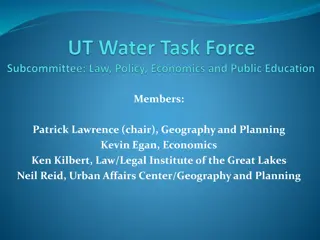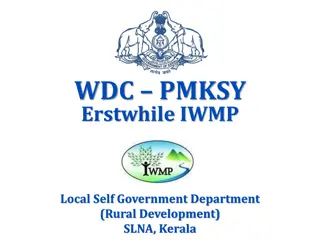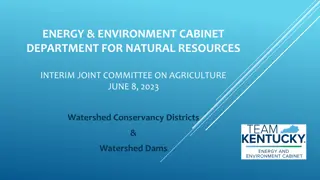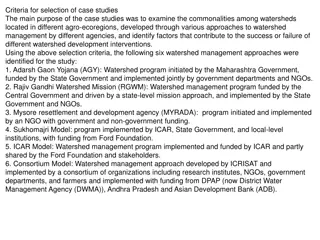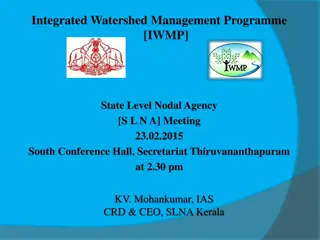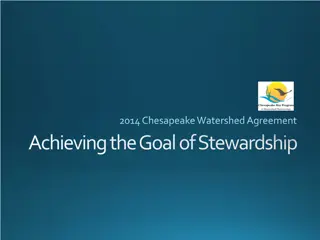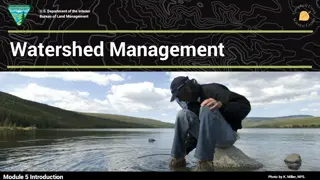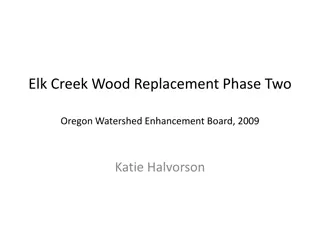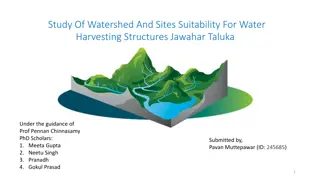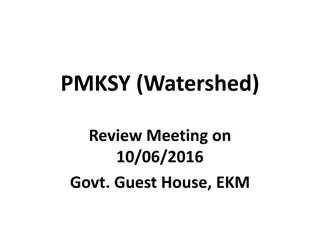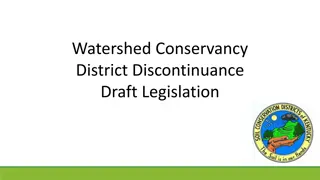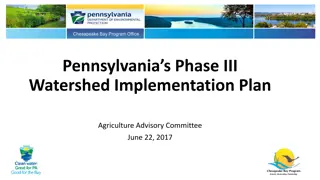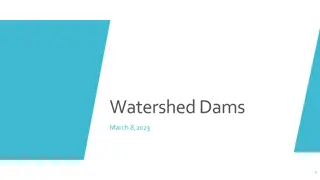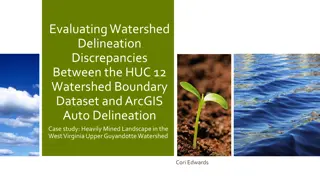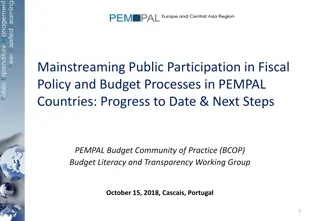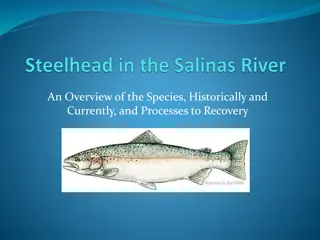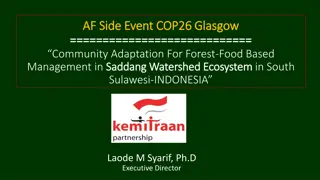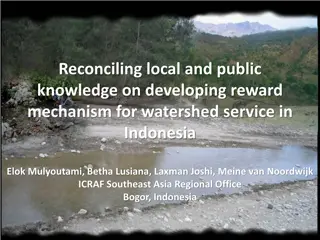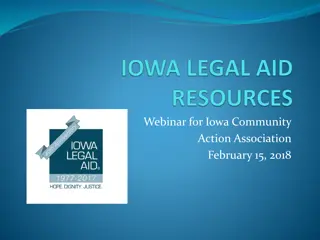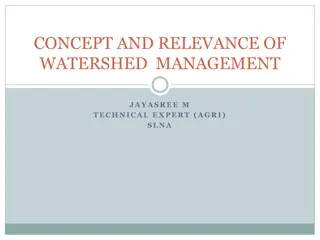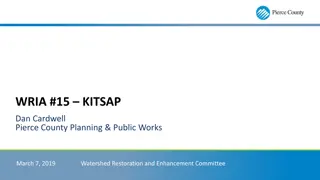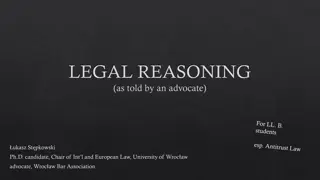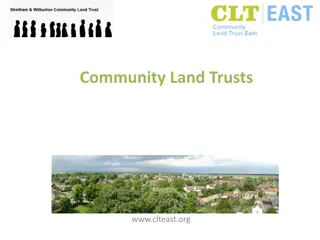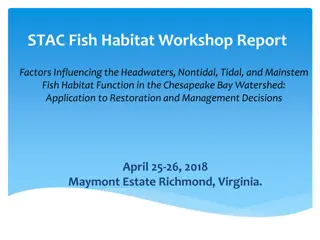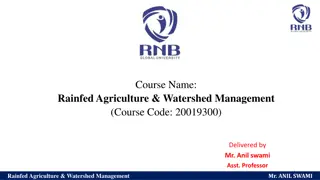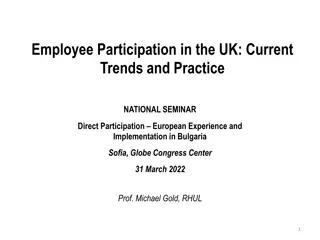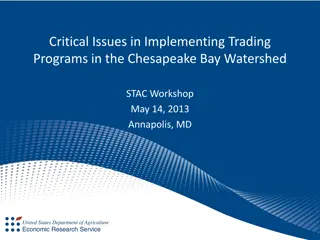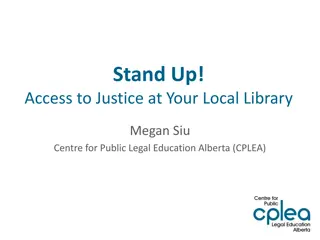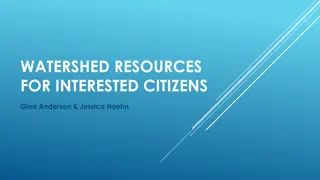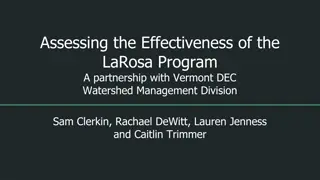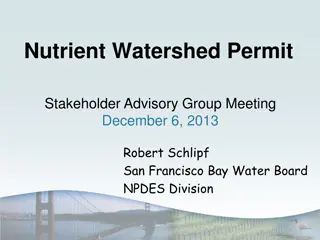Issues in Watershed Management: Policy, Legal, and Community Participation
Policy and legal frameworks play a crucial role in enhancing community participation in watershed management. Understanding policy impacts, participatory processes, and implementation strategies are key for effective management planning. Definitions of policy, its components, and what it is not are discussed to provide clarity. A supportive policy environment is essential for successful watershed management, emphasizing decentralized development, collaborative institutional arrangements, and alignment with local legislation and practices.
- Watershed Management
- Community Participation
- Policy Frameworks
- Legal Frameworks
- Institutional Arrangements
Download Presentation

Please find below an Image/Link to download the presentation.
The content on the website is provided AS IS for your information and personal use only. It may not be sold, licensed, or shared on other websites without obtaining consent from the author. Download presentation by click this link. If you encounter any issues during the download, it is possible that the publisher has removed the file from their server.
E N D
Presentation Transcript
CHAPTER ONE ISSUES IN WATERSHED MANAGEMENT 1.1 Policy and legal opening to enhance community participation 1.2 Socio-economic issues 1.3 Institutional issues
Policy and legal opening to enhance community participation in watershed management perspectives Learning outcomes Students are expected to oUnderstand policy and laws that have impacts on watershed management in a broader context oUnderstand the participatory policy making process oIntegrate different policy areas to facilitate watershed management planning oIdentify potential strategies for the implementation of the policy
Definitions of Policy A projected program of goals, values and their consistent practice over a considerably long period of time which benefit from periodic review . Policy is a comprehensive formulation of : oPrinciples oObjectives oTargets oAims
oBroad guiding statements that define the mandate and objectives of sectoral agencies. oAim at providing comprehensive integrated and coordinated frameworks for the management of both human and physical resources towards a sector s objectives; and usually develop with reasonable order and predictability oPolicies at both the national and sub-national level provide a framework for government decision making.
A policy should be Comprehensiveness Time Flexibility Cost Ownership Implementability Participation
What a Policy is not oPolicy is not legislation but a guide to legislation. oPolicy is not an abstract wish but a response to needs/demands of socio- political and economic context out of which it evolves. oPolicy is not static but dynamic. oPolicy is not timeless wish but an expression of what should be done in response to felt needs and in relation to time.
policy Watershed management works best when there is a supportive policy and legal framework, particularly a) Policies that facilitate decentralized and participatory development; that allow and encourage public b) Institutional arrangements agencies at all levels to work together; and c) An approach to access to natural resources that reflects local legislation and tenure practices and problems.
What are the existing enabling environments? a) Constitutional Provisions Environmental rights (art.44) (....right to a clean and healthy environment) Sustainable development (art.43) (.... right to sustainable development) Responsibility of government (art.92) The design and implementation of programs and projects of development shall not damage or destroy the environment ensure consultation
b) Governments PASDEP (Plan for Accelerated Sustainable Development to End Poverty) strategy a) Strengthening tenure security by expanding the ongoing and certification project; b) Building capacity in community-based approaches to watershed management; c) Scaling up successful models for watershed management; and d) Strengthening natural resource information management,... dissemination of best management practices in sustainable land management (SLM) Since 1980, the government has supported rural land rehabilitation, these aimed to implement natural resource conservation and development programs in Ethiopia through watershed development (MOARD, 2005).
c) Climate-Resilient Green Economy (2011) introduction of lower emitting techniques, such as oconservation agriculture, ocommunity based watershed management, and onutrient and crop management, could reduce emissions.. oWatershed-based integrated farming systems
Participatory policy making Participatory policy-making is more of a general approach than a specific tool , as the overall goals, no matter which method is followed, are to facilitate the inclusion, via consultative or participative means, of individuals or groups in the design of policies, and to achieve accountability, transparency and active citizenship. The push for this participatory process can be top-down (i.e. by the government/organization initiating participatory approaches to policy-making) or bottom-up (i.e. by particular stakeholder groups advocating a participatory approach or seeking to influence a specific policy).
Participatory approaches and community watershed management plans have been widely used with varying success in reconciling the overlay of human activity on naturally defined watersheds. participatory watershed management involves all actors to jointly discuss their interests, prioritize their needs, evaluate potential alternatives and implement, monitor and evaluate the project outcomes (Azene and Gathriu, 2006).
Participation is not a straightforward concept. Rather a number of conditions are necessary, these includes 1. The watershed program must include demand-driven activities. 2. People must be aware of the advantages of collective action in conserving and managing natural resources, and they must be empowered to plan, implement, and manage the programs. 3. People should expect private economic benefits
Participatory policy making (contd) The continuum of participation used by the World Bank is commonly referred to as the ladder of participation and can be summarized as: Information sharing: one-way flows of information to the public. Consultation: two-way flows of information between the coordinators of the consultation and the public. Joint decision making. Empowerment: transfer of control over decision making and resources to stakeholders.
Participatory policy making levels (contd) The continuum of participation can include other steps in the ladder: 1. Contribution: voluntary or other forms of input to predetermined programs and projects. 2. Information sharing: stakeholders are informed about their rights, responsibilities & options. 3. Consultation: stakeholders are given the opportunity to interact and provide feedback, and may express suggestions and concerns. 4. Cooperation and consensus building: stakeholders negotiate positions and help determine priorities, but the process is directed by outsiders. 5. Decision making: stakeholders have a role in making decisions on policy, project design and implementation.
Participatory policy making levels (contd) 6. Partnership: stakeholders work together as equals towards mutual goals. 7. Empowerment: transfer of control over decision-making and resources to stakeholders
Benefits of Participatory policy making The benefits of participatory policy making include (Veit and Wolfire 1998) oBetter informed policies: Policy making/reform requires diverse and complex information and expertise. oMore equitable policies: Policies that have been designed with attention to local peoples needs are more likely to be equitable and fair. oStrengthened transparency and accountability: oStrengthened ownership: oEnhanced capacity and inclusion of marginalized groups: oEnhanced government capacity: oCommon understanding: It can help promote a common understanding around complex, misunderstood or even antagonistic issues.
Policies and policy analysis Environmental policy and strategy-1997 Constitutes eleven-sectoral and eleven cross-sectoral policy elements The Overall Policy Goal to improve and enhance the health and quality of life of all Ethiopians and to promote sustainable social and economic development through the sound management and use of natural, human-made and cultural resources and the environment as a whole so as to meet the needs of the present generation without compromising the ability of future generations to meet their own needs
Environmental policy and strategy-1997 CROSS SECTORAL POLICIES SECTORAL oSoil conservation oGenetic, species & biodiversity oWater resources oEnergy resources oMineral resources oControl hazardous material and pollution from industrial wastes oAtmospheric pollution and climate changes oCultural and natural heritages oForest and woodland oHuman settlement and Urban environment o Population o Community participation o Gender o Environmental research o Environmental Education o EIS o Environmental Economics o EIA o Land use o Tenure and Access
Water Sector Policy and strategy - 2001 The overall goal is : to enhance and promote all national efforts towards the efficient, equitable and optimum utilization of the available Water Resources of Ethiopia for significant socioeconomic development on sustainable basis Regarding watershed management Recognize that water resources development, utilization, protection and conservation go hand in hand and ensure that water supply and sanitation, irrigation and drainage as well as hydraulic structures, watershed management and related activities are integrated and addressed in agreement.
Regarding watershed management.... Promote practices of efficient and appropriate watershed management to maximize water yields and quality. Ensure that watershed management practices constitute an integral part of the overall water resources management.
Water sector strategy oUndertake soil and water conservation measures oRehabilitate degraded watersheds and regenerate natural vegetation. o Establish soil and water conservation guidelines in relation to water resources development and ecosystem management oEncourage and promote local community participation in watershed management and water conservation measures
Land policy Land policy content The federal land administration and land use proclamation 1997 All land belongs to the state and peoples of the Ethiopia and shall not be subjected to sale or to other means of exchange (art 40.2 proclamation No. 1/1995 Federal level has legislative power; states are in charge of implementation Rural land administration and land use proclamation No, 456/2005 ( which replaced 89/1997) Aim increase tenure security, improve productivity and avoid expectations of land re- distribution. Farmers have a perpetual use right on their agricultural holdings, and this right will be strengthened by issuing certificates and keeping registers The federal land law only provides a framework. Each region arranges land registration in its own regional proclamation Related legislation importance to land governance Investment proclamation and regulations 2002,2003,2008 Investment proclamation and regulations governing incentives provided to foreign and domestic investors Biofuel energy 2007 Bio-energy production by foreign and domestic investors with government providing land, financial and other incentives support. Leasing out the lands will not interfere with crop production/feed security Directive council of ministers 2010 Centralization at the federal level of procedures for allocating large-scale land leases of over 5000 ha to investors: delegation to regional government (FDRE, 2010)
Forest Development Policy and Strategy (2007) objectives of the policy include organizing trainings to persons who are engaged in forest resource development activities; satisfy the forest product needs of the community by sustainably enhancing and conserving forest resources; and foster the contribution of forest resources to food security; etc. It provides for the development of forests by individuals; associations; and other organizations. Stresses the need for the appropriate conservation of forest resources with community participation
Rural Development Policy and Strategies (2003) Key elements of the RDPS include: rural and agricultural centered development as a means of: I. ensuring rapid economic growth; II. enhancing benefits to the people; III. eliminating food aid dependency; and IV. promoting the development of a market oriented economy.
Agricultural sector policy and investment framework (PIF) Thematic area Strategic objectives Productivity and SO1: To achieve a sustainable increase agricultural production productivity and production Rural commercialization SO2: To accelerate agricultural commercialization and agroindustry development Natural resources SO3: To reduce degradation and improve productivity of management natural resources Disaster risk management SO4: To achieve universal food security and protect and food security venerable households from natural disasters
Sustainable Land Management Project (SLMP) Under the SLMP only 55 watersheds out of the 177 that have been prioritized in food secure areas are financed and there are many more watersheds in food insecure areas also in urgent need of attention.
International/Multilateral Agreement The international agreement to which Ethiopia is a signatory includes: oConvention on Biological Diversity ratified in 2003 oThe United Nations Convention to Combat oDesertification- Ratified in 1997 oThe Vienna Convention for the Protection of the Ozone Layer oFramework Convention on Climate Change (FCCC) oThe Basel Convention oThe Rotterdam Convention
Integration of different policies The integrated implementation of cross-sectoral and sectoral federal, regional and local policies and strategies shall be seen as a prerequisite to achieve the objectives of any policy. For instance: The environmental policy underscores that the policy ensures forestry development strategies integrate the development, management and conservation of forest resources with those of land and water resources, energy resources, ecosystems and genetic resources, as well as with crop and livestock production;
Policy Implementation Policy Implementation is the stage of policy-making between the establishment of a policy and the consequences of the policy for the people whom it affects. Implementation involves translating the goals and objectives of a policy into an operating, on going program. The fragmentation of authorities affecting watersheds, both horizontally and vertically, complicates the process of making and implementing watershed policy. Ministry of Agriculture and Rural Development (MoARD) is responsible for: odevelopment and natural resource management (Proclamation 380/2004).
Policy Implementation (contd) Agriculture and Rural Development Bureau (ARDB) is responsible for: management of land, forest, wildlife and biodiversity resources (Proclamation No 110/2007). Ministry/ Bureau of Water and Energy responsible for the conservation, utilization and development of water resources in the country (Proclamation No 4/95).
Policy Implementation (contd) Elements of implementation oClarity of goals oAdequate resources oCapacity of permanent executive oMechanism of coordination oPolitical and judicial support
Perfect Implementation (10 preconditions.....) 1. External circumstances do not pose any significant constraint to the implementing agency 2. Adequate time and sufficient resources are available for the program 3. Combination of resources is actually available 4. The actual policy is based upon a valid theory of cause and effect and isn t irrational 5. Relationship between cause and effect is direct with few/no intervening links 6. Dependency on other agencies/organizations is minimal
7. Understanding and agreement re: objectives 8. Tasks are fully specified in the correct sequence 9. Perfect communication and co-ordination 10.Perfect obedience those in authority can demand and obtain perfect compliance
1.2. Socio-economic issues Social aspects in WM 1. Watershed management organization Social Component It is centered around the decision-making aspects Organizational Set-up Assessment Planning Implementation Evaluation
Organizational set-up Goal of local watershed management organizations is to protect, preserve, restore natural resources through 1) Assessment What is happening in the watershed? 2) Planning- What needs to be done? Goals Statements that describe the desired future watershed condition toward which programs, activities, and decisions are directed. Policies The strategic steps, or intermediate ends, required to reach the watershed s goals. Strategies The specific actions by which the community will achieve its goals
Organizational set-up (cont...) 3) Implementation How do you get there? oStrategies or the tasks that need to be done in order of priority. oTime Frame for tasks to be completed. oCapital Improvement Plan which provides estimates of the funding needs for each task. 4) Evaluation Did you make it?
Generally, social mobilization, community organization, building capacities of communities in planning and implementation, ensuring equity arrangements all need intensive facilitation. Social rationality in watershed management deals with taking into account the social or people setting. The watersheds may include lands belonging to different social groups and also the activities and outcomes of watershed development may affect various social groups differently. Achieving the acceptance and cooperation of different social groups usually becomes necessary for effective implementation of watershed projects.
In the absence of addressing social rationality, transaction costs may escalate, difficulties arise and performance may suffer. Participatory approaches and community watershed management plans have been widely used Participation is not a straightforward concept. A number of conditions are necessary for people to actually participate in WM programs (as discuss in policy issues).
Generally, human resource development is an important component of watershed development Formation of people s institutions and working through these institutions at all levels, (kebele to National) involvement of women through all possible means, introduction of income generating activities are some of the activities undertaken to develop human resources.
Capacity building the sum of the efforts needed to develop, enhance and utilize the skills of people and institutions to follow a path of sustainable development. (UNDP 2001) Capacity building is a crucial component to achieve the desired results from watershed development projects. Capacity development, as defined by FAO (2010), is the process whereby individuals, organizations and society as a whole release, strengthen, create, adapt and maintain capacity over time . oIt involves social and political aspects and not only technical ones. oCapacities must be developed at the individual level, at the level of organizations and in the enabling environment.
Functional capacities refer to the capacities needed to take up and sustain changes. They are relevant for: all technical sectors and include soft skills (i.e. communication, negotiation and advocacy) and managerial skills such as policy formulation, project management, leadership, strategic planning, knowledge exchange and partnership building. Technical capacities are those needed for an adequate response to the technical challenges faced in a specific project situation. In a watershed context, for example, technical capacities may relate to sustainable natural resource management practices, ecosystem valuation, watershed zoning and planning, participatory approaches, GIS, value chain development or market analysis.
Key Elements of Capacity Building Strategy Dedicated and decentralized institutional support and delivery mechanism Annual Action Plan for Capacity Building Pool of resource persons Well prepared training modules and reading materials Mechanism for effective monitoring and follow-up. Resource Organizations and Developing Partnerships
Some critical capacity building components 1. strengthening political and financial support 2. strengthening human resources: education, training and awareness building 3. strengthening information resources: monitoring, data integration and interpretation for informed decision-making; 4. strengthening regulations and compliance; 5. strengthening basic infrastructure 6. Strengthening Local enterprises.
Interdependent components must become integrated integrated capacity building (ICB)
Limited vs. full scale capacity building Capacity building needs are large and resources limited. Where to start within a watershed (what element, level) ? Initial Capacity assessment (the existing capacity building and the gaps) Capacity threshold for: A. political and financial B. Human resources C. Information resources D. Policy E. Basic infrastructure F. Local enterprises
Gender empowerment Participatory Watershed management is a multidisciplinary, multi institutional approach for NRM and providing food security through diversification of livelihood options and increased productivity. Women are key to address household food security. Women play a major role in Agriculture and livestock development Health and Education of women has an immediate and lasting effect on the well being of the family Since most percentage of the poor are women, they along with other resource poor are central targets for watershed development.
Major lessons learnt Evaluation of a no.of watershed programs have indicated the importance of: People s participation in development process which determined the success Role of institutions for enhanced participation A combination of participation and sound technical input Need for supporting policy Watersheds as vehicles that reversed environmental degradation and permitted quantum shift in sustainable agricultural productivity In the process women paid the price of development in most cases ( Nutrition, Security, Basic amenities, workload) Social issues are addressed through involvement of women and minority
Organizations for IWM: Indian Example Government state and federal District Rural Development Agency Project Implementing Agency (PIA) Watershed Development Team Village admin council (Gram panchayat) Watershed association/committee Local user groups (for land owners) Local self help groups (land-less)
